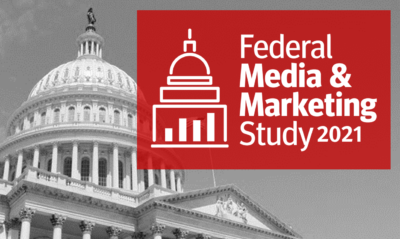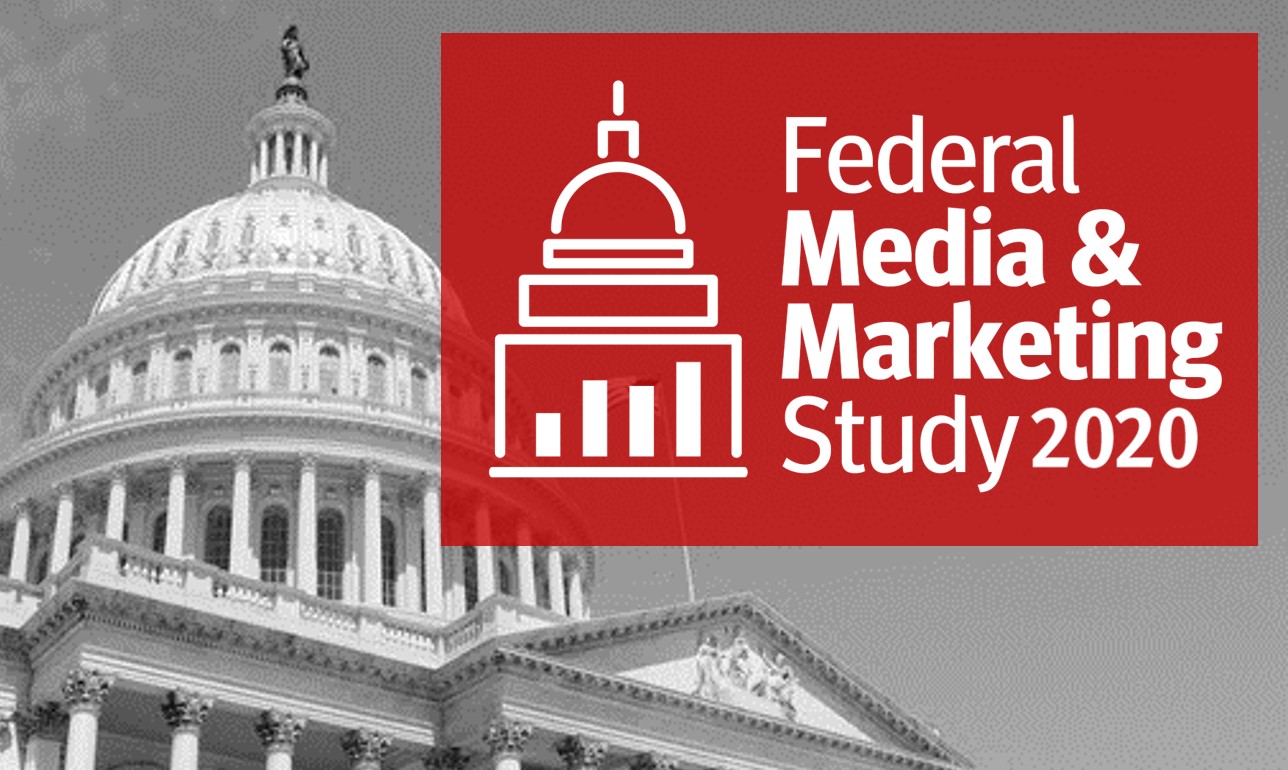Federal Media
 FEDERAL MARKETERS MUST STAY ABREAST TO REACH TARGET AUDIENCES
FEDERAL MARKETERS MUST STAY ABREAST TO REACH TARGET AUDIENCES
It’s no surprise to anyone that the way we are seeking and receiving news has been changing and evolving. Gone are the days of starting your morning off with a coffee and newspaper, listening to news radio on the way to work or waiting for the 6 or 11 PM evening news. Over the years, news media has evolved to include blended online/print publications, 24-hour news stations, online news, and more recently, online social media and cell phone notifications.
Recent events and changes to the workplace have only accelerated the change. Federal marketers, like many others, must respond and adapt to these changes or else get left behind.
Many External Factors Affect Federal News Consumption
In years past, we have focused our Federal Media & Marketing Study on media channel preferences and the level of trust and confidence in those media properties. In many areas, 2020 was an accelerator, with both the onset of COVID19 as well as historical elections. The impact of the year’s events on the amount of news and the sources relied upon were reflected in the 2020 study results of federal respondents, including:
- Dousing the firewalls. Federal respondents’ ability to telework improved access to previously blocked sites on personal devices throughout the day.
- Shrink in the ink (including industry print). Most print publications were delivered to workplaces and passed along to colleagues. With employees working remotely, many lost access to these resources.
- Drive time crash. Remote work affected “morning drive” listenership negatively and likely will into the future; however, we heard anecdotally that listenership did spread and increased throughout the workday.
- Say her name. Daily radio listenership showed increases, potentially attributed to news radio being available streaming and easily summoned via Alexa/Google.
- Sourdough recipes and the news. Federal employees could access social media on personal devices throughout the day. LinkedIn, Instagram, Twitter and Reddit usage increased significantly in 2020. Pandemic updates and a historic election year, with candidates and campaigns communicating much more via social media channels, put social media front and center.
- Skeptics abound. There was also a significant decline in confidence across media outlets in 2020. Political polarization and concern with media bias continued.
Feds, like the rest of us, are affected by extenuating factors. Marketers must not always rely on tried-and-true methods of the past but keep an eye on the horizon and make necessary pivots based on data available.
What Should Federal Marketers Pay Attention to in 2021?
We’ll continue to look at trends and impacts on federal employees’ media usage, preferences, new and upcoming channels, and NEW THIS YEAR, where feds go for their local and breaking news.
Where federal employees go for local news can prove to be useful in building a tailored media plan across the country. A better understanding of “go-to” news sources and trusted news channels can put your message where their mind is. This may be the place to concentrate both paid and unpaid media and marketing efforts.
Need data to help make informed media purchasing decisions? Our 2021 Federal Media & Marketing Study provides the information you need.
Need more custom research to learn about your customer’s needs, challenges, barriers, perceptions and preferences, contact us to see how we can help.

Federal Media & Marketing Study 2021
13th Annual Study: On-Demand Video and Presentation Followed by Small Group Discussions
UPDATE! The 2021 FMMS will now be On-demand
Release date: October 21, 2021
Due to concerns with COVID-19 variants, forthcoming mandates, and to protect the health and safety of our participants, we have made the executive decision to transition the 2021 Federal Media & Marketing Study release to on-demand video presentation and download report.
In its 13th year, the Federal Media & Marketing Study continues to empower marketers to hone and perfect their strategic marketing campaigns with valuable and reliable data directly from their federal customers. The survey provides key information about the federal audience’s media usage across print, broadcast, social and digital sources. Combining this data with demographics including: job function, location, purchase area and more, marketers have the ability to slice and dice the data and map each to specific media habits, allowing them to target specific audiences.
The survey represents the views of thousands of federal workers in a variety of positions. Whether you are interested in a broad awareness campaign, or a more focused agency-based marketing effort, data from the study can provide you key insights about the media and marketing habits of this tough-to-reach federal market audience.
WHAT TO EXPECT
- Job Function and Purchase Responsibility – More than 25 different job functions and areas of purchase, by product and service
- Media Usage – 60+ publications, 100+ websites and mobile sites; 10+ social sites; differences inside vs. outside the Beltway
- Trusted Content -To what extent do decision makers trust news and information from different media sources?
- Time Spent Accessing Content – How much time do government employees spend accessing content online, watching TV, listening to the radio and reading e-newsletters?
TWO PANEL DISCUSSIONS
Federal Media Panel: Moderated by Aaron Heffron, Market Connections
- Kevin Baron, Executive Editor, Defense One
- Patti Nuttybombe Cochran, Federal Marketing Consultant, Government Matters Media
- Jeffrey Wolinsky, Director of Federal Sales, WTOP/Federal News Network
Federal Marketing Panel: Moderated by Stephanie Geiger, Government Marketing University
- Matt Bechtel, Director of Corporate Marketing, Booz Allen Hamilton
- Allison Mason, Senior Director, Public Sector Marketing, Red Hat
- Darryl E. Peek II, Head of Federal Strategic Partnerships, Google
ON-DEMAND ACCESS and POST-FMMS ONLINE NETWORKING SESSIONS
- ON-DEMAND VIDEO AND REPORT – Our 2021 report and video presentation will be available to download on October 21. Stay tuned for purchasing capabilities
- SMALL GROUP ONLINE DISCUSSIONS – A series of online groups (no more than 20 per session) will be limited to FMMS on-demand purchasers to discuss results and network with like-minded peers following the FMMS release. Details on registration will be available in after purchase.
PURCHASE THE OVERVIEW & VIDEO!
Overview results from the 2021 Federal Media & Marketing Study highlights high-level results from our comprehensive study surveying thousands of federal respondents at defense and civilian agencies, inside and outside the Beltway about their use of digital, social, mobile, print and broadcast media. This PDF report provides high-level results of the top digital and print publications, social media sites, radio and TV within the DC metro area. A video readout and analysis of the results by President, Aaron Heffron, is included with purchase.
 Increasingly over the past few years, federal marketers have been asked by senior management to prove a positive return on investment on their marketing dollars. In today’s altered landscape, marketers are also faced with having to account for their target audience’s changing work environment and agency priorities. With this in mind, what questions should federal marketers ask before their strategies are developed and investments made?
Increasingly over the past few years, federal marketers have been asked by senior management to prove a positive return on investment on their marketing dollars. In today’s altered landscape, marketers are also faced with having to account for their target audience’s changing work environment and agency priorities. With this in mind, what questions should federal marketers ask before their strategies are developed and investments made?
Who Are You Targeting?
Earlier this year, our President, Aaron Heffron wrote about the difference between expanding versus exploring when it comes to your customer base. Regardless of whether you are looking to expand your customer base to new agencies or looking to build deeper relationships with the agency you are currently working with, it’s important to know your customer’s preferences, learning styles, preferred communication styles and the challenges they are facing.
Agency-based marketing (and even people-based marketing) are terms we hear more and more. Sales and marketing need to work together to develop their buying personas to understand who and how to best approach the marketplace. Using data versus anecdotes will yield the best results. Whether you develop your own personas or look to the Federal IT (FIT) Persona Study, knowing your customer will increase the ROI on any marketing effort.
Will Your Message Resonate?
Before launching any new campaign (especially grand (read: expensive) ones), it’s a good idea to include message testing research in the beginning to create a baseline and ultimately demonstrate the ROI from beginning to end. Pre-testing your messaging provides information on your prospects’ awareness of your brand and a read on how well your message fits within that brand perception. Returning to a similar audience to test the change in awareness and perceptions allows for dynamic message refinements and adjustments to ensure resonance and relevance with your audience. Agency priorities can change swiftly, and contractors often need to be able to change with the tides.
How Should It Be Delivered?
Once you have an idea about what you want to say, how is it best delivered? Depending on whether you want to create awareness or influence buying decisions, your content may need to take different formats.
Public sector marketers know content is king, but you will need to consider your target audience’s learning preferences. Do they tend to read, listen, or watch content to learn more about the services or products? Are they looking for past examples of how new ideas have worked or seeking knowledge (and reassurances) from industry or government thought leaders?
Over the years, we periodically dove into the world of content marketing. Our 2017 Federal Content Marketing Review highlighted what content federal audiences want during the different steps of the buying process. The 2019 Content Marketing Review introduced state and local audiences into the mix. In 2021, we will reprise the study and assess the K-12 and higher-ed markets and review how COVID-19 may have impacted preferences from years past. (Register for the 2021 Content Marketing Review: Reaching the Public Sector)
Where Should You Place It?
Whether earned or paid, you want to ensure the content created is reaching the right eyeballs. In times of tightening budgets, every marketing and advertising dollar spent needs to be well-thought out. Targeting matters. Some media channels can be more effective for a general federal audience, while others can most efficiently reach an agency, agency-type, or professionals with a specific job function or within a purchase category. The Federal Media and Marketing Study provides you data about their media usage across print, broadcast, social and digital sources.
This is especially important in years where their habits may have changed. Various factors are challenging conventional wisdom. With more federal employees teleworking, things such as radio advertising, print advertising and social media use have been deeply affected. Having the data to back your advertising decision will help you decide where to invest your advertising and marketing dollars.
Final Thought
Data-enabled informed strategic decisions can help maximize ROI. Market Connections has spent the past 25 years gathering data and insights from public sector influencers and decision-makers to support our government contracting clients in informing their strategic planning, validating their marketing spend and ensuring the best ROI possible.
Want to learn more or develop a custom study for your audience, contact us at info@marketconnectionsinc.com.
In our last blog post, Should You Reconsider Your 2021 Federal Media Strategy in Light of COVID?, we touched on how to use agency-based marketing (ABM) for media purchasing when space in general federal publications are limited.
Federal marketers are oftentimes challenged with tight budgets and high expectations to produce strong ROIs. Simply, they are expected to do a lot with very little. Agency-based marketing when paired with investments in advertising and other broad marketing strategies can provide a boost to the expected return on investment.
What is one way to maximize a small budget? Effectively connect with the preferences of your TARGET audience with a strong understanding of what makes them tick day to day.
Using Personas to Connect
There are many ways of developing personas, depending on your needs and resources. A good place to start is your own Customer Relationship Management (CRM) tool and your client-facing teams. If you need deeper insights your tool cannot provide or have been surprised by conflicting comments from your teams, you may want to consider third-party research. Using personas helps you drill down on your customers’ preferences and develop a focused strategy tailored specifically to them.
For federal marketers, that can mean a focus on agency type, agency-specific, geographical, or product/service categories. Understanding your customer on a deeper level can help you speak to their personal and professional goals and challenges. For example, if you are targeting an IT end-user, you may focus on educating about more technical features because of their desire to be an expert in their agency, whereas if you were marketing to a procurement specialist, you would want to focus on cost-savings because of their pride in being prompt and efficient. In the same vein, one may prefer to watch a webinar, while another prefers to read a white paper due to their personal learning preferences.
Learn more about Market Connections’ Federal IT Personas.
Consider “Where” They Are Already Going
In addition to content creation, you may want to consider where and how you are advertising or sharing your content. Whether it’s because space is at a premium in some of the more general federal publications, or you are focusing on more niche publications based on your particular audience, understanding where your audience is going for news and information can help get the right eyeballs on your content and drive agency decision-makers to your site.
Ad placement is only one lever you can use and is often most effective to build awareness. If you are having difficulty closing sales among those who know you, consider delivering information and messages through other popular channels among your target audience. They may have a preference for a certain social media platform. They may use certain streaming services to reach specific news programs or tune into radio stations throughout the day. Of those media channels, are there geo-locating advertising opportunities you may want to explore to reach your prospects?
Selecting correctly from your customer’s media buffet of online publications, print publications, social media sites, TV, radio or streaming services can eliminate some of the “guesswork” and improve the ROI on your marketing investment.
Learn more using our annual Federal Media & Marketing Study.
Looking Deeper
Consider diving a little deeper and consider more targeted marketing as part of your overall federal marketing strategy. Beyond creating tailored content that is relevant to your specific audience, also consider the format and placement of that content. Federal marketers have many tools available that can pair nicely with internal intelligence to help make educated decisions about their company’s federal marketing investments.
Insights Pulled from a Sneak Peek of the 2020 Federal Media & Marketing Study

Laurie Morrow, Vice President of Research Strategy
From the desk of Laurie Morrow, Vice President of Research Strategy, Market Connections Inc.
Over the twelve years my team has conducted the Federal Media & Marketing Study, we have looked at how federal audiences are engaging with different media properties from print publications to online to newer social medias. In addition to analyzing readership, we also investigate habits, trends, levels of trust and confidence and time spent with media along with other marketing tactics year over year.
With all the changes and pivots the federal market and those marketing to them had to make this year, I was eager to see whether there would be changes in this year’s results due to the pandemic, elections and other recent major events.
Taking a sneak peek into the findings, I found some interesting results around trust and confidence that while not tied to pandemic, may be a result of a charged political and social climate this year.
Confidence in News
The first is an overall decline in confidence in general news media. Like others, I was not necessarily surprised by this finding, as we started to see some drops in confidence in general news sources last year tied to political party affiliation.
What I did find surprising was seeing a decline in some federally focused media as well this year. Over the years, the level of confidence in federal news outlets has relatively remained unscathed but has distrust now seeped into federal media? Is this due to the charged climate, or do we expect to see this trend continue to grow in an era where “fake news” and general distrust in media grows along political and geographical lines?
Trust in Source
Similar to the level of confidence in news, this year’s results indicate an overall decline in trust of ALL sources of information, from associations to industry pubs to government contractors. While the ranking of trust in sources is relatively the same as last year, the general decline across the board could possibly point to a growing skepticism within the federal audience. In coming years, we will continue to measure that level of trust to see if this continues to trend down or if this current dip in trust is due to the current climate.
Regardless of whether this is a trend or not, this begs an important question, “What can we do as an industry to regain our federal customers’ trust?”
Other Results
In addition to details around the level of confidence in media properties and rank sources of information by trustworthiness, the 2020 Federal Media & Marketing Study most notably studies the readership of general and federal publications, social media site usage, and television viewership and radio listenership (for the DMV), among other marketing tactics. We highlight any differences found by agency type, location (inside the beltway vs. outside), party affiliation, and geography (urban, suburban, rural) among other characteristics, where statistically different.
Learn more about our study, purchase the on-demand overview and/or annual subscription to the dashboard.
https://www.marketconnectionsinc.com/fmms2020study/
Federal Media & Marketing Study 2020

12th Annual Study On-Demand Release*
Thursday, October 29, 9 AM
*Due to COVID-19 and the inability to present results in an in-person breakfast, the 2020 study results are available as an on-demand video and downloadable overview presentation.
PURCHASE ON-DEMAND VIDEO & OVERVIEW
ABOUT THE STUDY
In its 12th year, the Federal Media & Marketing Study continues to empower marketers to hone and perfect their strategic marketing campaigns with valuable and reliable data directly from their federal customers. The survey provides key information about the federal audience’s media usage across print, broadcast, social and digital sources. Combining this data with demographics, including job function, location, purchase area and more, marketers have the ability to slice and dice the data and map each to specific media habits, allowing them to target specific audiences.
The survey represents the views of thousands of federal workers in a variety of positions. Whether you are interested in a broad awareness campaign, or a more focused agency-based marketing effort, data from the study can provide you key insights about the media and marketing habits of this tough-to-reach federal market audience.
WHAT TO EXPECT
- Job Function and Purchase Responsibility – More than 25 different job functions and areas of purchase, by product and service
- Media Usage – 60+ publications, 100+ websites and mobile sites; 10+ social sites; differences inside vs. outside the Beltway
- Trusted Content – To what extent do decision makers trust news and information from different media sources?
- Time Spent Accessing Content – How much time do government employees spend accessing content online, watching TV, listening to the radio and reading e-newsletters?
- Media Habits of Federal Employees: A Day in the Life – What media sources are federal employees accessing during different parts of their day?
NEW IN 2020
- The Effects of COVID-19 – From media habits to in-person events, what should marketers know to adjust their strategies?
- Virtual Events and Webinars – With live events on hold for the time being, when it comes to planning your virtual events, what should you take into consideration? What are feds’ preferences?
- Teleworking and Commuting – How much are feds teleworking or commuting and how does this change their media habits?
- Geography – Are there differences among federal employees who live and work in urban, suburban and rural environments?
 Every year, Market Connections’ Federal Media and Marketing Study helps companies meet their federal customer “where they are.” Whether it’s raining, snowing, sunny, hot or cold where they are, one thing we can forecast for sure, Weather.com and AccuWeather.com are among the most frequently visited digital sites by federal workers year after year.
Every year, Market Connections’ Federal Media and Marketing Study helps companies meet their federal customer “where they are.” Whether it’s raining, snowing, sunny, hot or cold where they are, one thing we can forecast for sure, Weather.com and AccuWeather.com are among the most frequently visited digital sites by federal workers year after year.
New this year, we also found that weather apps are the most downloaded mobile applications with an average of one out of five federal workers having these apps on their mobile device.
These results cause us to joke internally that, “Weather is King!” Does this mean you should advertise on these sites or wrap yourself around these apps?
While we know all those federal eyeballs are staring at the skies, weather sites (and apps!) may not be the most effective marketing channels to reach your government audience. While they are among the most visited and downloaded, you need to consider the goals for your advertising before investing. If your goal is an introduction and top-of-mind awareness, maybe it is. If you are being measured on the depth of understanding that an agency has of your product, weather may not rule your advertising spend.
Websites like Weather.com and those who advertise there clearly understand their reach. The volume of advertising on these sites is unrivaled. If you decide to allocate your advertising dollars on these populated sites, you must ask yourselves, “How can I stand out from the other advertisers?” Differentiation is difficult in advertising and especially among federal contractors. (Watch our webinar: Differentiation in a Federal Market: How Do You Stand Out?) Don’t waste broad-reaching dollars on something that will look like every other ad.
With federal marketing budgets often tight, it’s important to prove ROI. Do you have data that can help you make intelligent decisions about where to advertise? Whether you’re purchasing ad space to broaden awareness, or targeting media properties that attract a specific agency, location, or product type, expert marketers look to data to help them make these decisions.
Each year the Federal Media & Marketing Study provides information about the media habits of federal workers from an aggregate (overall) to granular (specific audiences) level. Understand what sites they’re visiting, publications they’re reading, radio stations they’re listening to or news shows they’re watching. Our study results help you weather through tough decisions and better forecast your ROI in the most effective way possible.
Join us on October 31 to hear this year’s results and receive a complimentary overview (Register here). Need the data sooner? Consider a subscription to the 2019 dashboard, available at last year’s price for a limited time and access data from 2016-2018 immediately, and the 2019 data as soon as it’s available (subscribe today).
